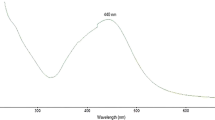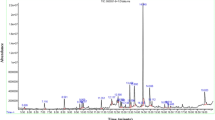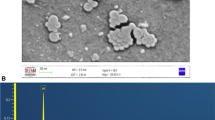Abstract
Plant-derived synthesis of silver nanoparticles (AgNPs) has found wide biomedical applications including cancer cure. This report deals with biosynthesis of silver nanoparticles (MZLAgNPs) employing leaf extracts of Manilkara zapota (L.) under optimized conditions. Characterization of MZLAgNPs using UV-Vis spectroscopy, FTIR, XRD, and FESEM analyses revealed that the particles were predominantly spherical averaging 24 nm in size. Their cellular effects were assessed by MTT assay, fluorescence, and scanning electron microscopy of cells stained with propidium iodide, acridine orange/ethidium bromide, and annexin V-FITC to visualize signs of apoptosis. Evaluation of cell proliferation by clonogenic assay, wound healing ability by scratch assay and cell cycle distribution by flow-cytometry was also carried out. Apoptosis-related gene expressions were analyzed by RTq-PCR and western blot analysis. MZLAgNPs selectively inhibited growth of colorectal carcinoma HCT116, HeLa, and non-small lung carcinoma A549 cells, dose-dependently with IC50 concentrations of 8, 16, and 29 μg/mL respectively, following 72-h treatment, without affecting growth of normal human lymphocytes and erythrocytes. Apoptosis induction was observed by fluorescence and scanning electron microscopy. Overproduction of reactive oxygen species (ROS), reduction of mitochondrial membrane potential, upregulation of apoptotic-related genes - PUMA, cas-3, cas-8, cas-9, and BAX, expression of caspase 3, and occurrence of PARP cleavage were observed in MZLAgNPs/cisplatin treated cells. Taken together, our results clearly demonstrate the therapeutic potential of biogenic MZLAgNPs as an effective agent for killing colorectal carcinoma cells by apoptosis induction.















Similar content being viewed by others
References
Anjum S, Haider BA, Khan ZS (2016) Plant mediated synthesis of silver nanoparticles for biomedical applications: challenges and opportunities. Park J Bot 48(4):1731–1760
Song JY, Kim BS (2009) Rapid biological synthesis of silver nanoparticles using plant leaf extracts. Bioprocess Biosyst Eng 32:79–84
Rajasekharreddy P, Rani PU, Sreedhar B (2010) Qualitative assessment of silver and gold nanoparticle synthesis in various plants: a photobiological approach. J Nanopart Res 12:1711–1721
Huang H, Yang X (2004) Synthesis of polysaccharide-stabilized gold and silver nanoparticles. A green method. Carbohydr Res 339:2627–2631
Xue B, He D, Gao S, Wang D, Yokoyama K, Wang L (2016) Biosynthesis of silver nanoparticles by the fungus Arthroderma fulvum and its antifungal activity against genera of Candida, Aspergillus and Fusarium. Int J Nanomedicine 11:1899–1906
Shankar SS, Rai A, Ahmad A, Sastry M (2004) Rapid synthesis of Au, Ag, and bimetallic Au core–Ag shell nanoparticles using neem (Azadirachta indica) leaf broth. J Colloid Interface Sci 275:496–450
Ahmed S, Ahmad M, Lal BS, Ikram S (2016) A plants extracts mediated synthesis of silver nanoparticles for antimicrobial applications: a green expertise. J Adv Res 7:17–28
Salunke BK, Sawant SS, Lee S-I, Kim BS (2016) Microorganisms as efficient biosystem for the synthesis of metal nanoparticles. Current scenario and future possibilities. World J Microbiol Biotechnol 32(5):1–16
Barabadi H, Ovais M, Khan ZH, Saravanan M (2017) Anti-cancer green bionanomaterials: present status and future prospects. Green Chem Lett Rev 10(4):285–314
Khatoon N, Ahmed JM, Sardar M (2017) Biotechnological applications of green synthesized silver nanoparticles. J Nanosci Curr Res 2:1. https://doi.org/10.4172/2572-0813.1000107
Xi Feng Z, Wei S, Sangiliyandi G (2016) Silver nanoparticles-mediatedcellular responses in various cell lines: an in vitro model. Int J Mol Sci 17(10):1603–1629
Ovais M, Khalil AT, Raza A, Khan MA, Ahmad I, Islam NU, Saravanan M, Ubaid MF, Ali M, Shinwari ZK (2016) Synthesis of silver nanoparticles via plant extracts: beginning a new era in cancer theranostics. Nanomedicine 11(23):3157–3177
Kovacs D, Igaz N, Keskeny C, Bélteky P, Tóth T, Gáspár R, Madarász D, Rázga Z, Kónya Z, Imre, Boros M, Kiricsi M (2016) Silver nanoparticles defeat p53-positive and p53-negative osteosarcoma cells by triggering mitochondrial stress and apoptosis. Sci Rep 6:27902. https://doi.org/10.1038/srep27902
Hackenberg S, Scherzed A, Kessler M, Hummel S, Technau A, Froelich K, Ginzkey C, Koehler C, Hagen R, Kleinsasser N (2011) Silver nanoparticles: evaluation of DNA damage, toxicity and functional impairment in human mesenchymal stem cells. Toxicol Lett 201(1):27–33
Banerjee D, Sengupta S (2011) Nanoparticles in cancer chemotherapy. Prog Mol Biol Transl Sci 104:489–507
Ranganathan R, Madanmohan S, Kesavan A, Baskar G, Ramia Y, Krishnamoorthy, Santosham R, Ponraju D, Kumar SR, Venkatraman G (2012) Nanomedicine: towards development of patient-friendly drug-delivery systems for oncological applications. Int J Nanomedicine 7:1043–1060
Milind P, Preeti (2015) Chickoo: a wonderful gift from nature. Int J Res Ayurveda Pharm 6(4):544–555
Ghani A (2003) Medicinal plants of Bangladesh: chemical constituents and uses, 2nd edn. Asiatic Society of Bangladesh, Dhaka, p 292
Kulkarni AP, Policegoudra RS, Aradhya SM (2007) Chemical composition and antioxidant activity of Sapota (Achras sapota Linn.) fruit. J Food Biochem 31:399–414
Priya P, Shoba FG, Parimala M, Sathya J (2014) Antioxidant and antibacterial properties of Manilkara zapota (L). Royen flower. Int J Pharm Clin Res 6(2):174–178
Anjaria J, Parabia M, Dwivedi S (2002) Ethnovete heritage Indian ethnoveterinary medicine, an overview. Pathik Enterprise, Ahmedabad
Patricia LDM, Maria RAM, Luis COL, Jose DA, Ricardo EA, Jose DS (2008) Cell wall biochemistry of sapodilla (Manilkara zapota) submitted to 1-methylcyclopropene. Braz J Plant Physiol 20:85–94
Anand P, Kulkarni RS, Policegoudra S, Aradhya M (2007) Chemical composition and antioxidant activity of sapota (Achras sapota linn.)fruit. J Food Biochem 31:399–414
Bhargava KP, Gupta M, Gupta GP, Mitra CR (1970) Anti-inflammatory activity of saponins and other natural products. Indian J Med Res 58:724–730
RB et al (1979) Steroid and triierpenoid saponms as spermicidal agents. Indian Drugs 17: 6–8
Ma J, Luo XD, Protiva P, Yang H, Ma C, Basile MJ, Weinstein B, Kennelly EJ (2003) Bioactive novel polyphenols from the fruit of Manilkara zapota (sapodilla). J Nat Prod 66:983–986
Fayek NM, Monem ARA, Mossa MY, Meselhy MR, Shazly AH (2012) Chemical and biological study of Manilkara zapota (L.) Van Royen leaves (Sapotaceae) cultivated in Egypt. Pharm Res 4:85–91
Rashid MM, Hossain MI, Osman MA, Aziz MA, Habib MR, Karim MR (2014) Evaluation of antitumor activity of Manilkara zapota leaves against Ehrlich ascites carcinoma in mice. Environ Exp Biol 12:131–135
Srivastava M, Hegde M, Chiruvella KK, Koroth J, Bhattacharya S, Choudhary B, SCR (2014) Sapodilla plum (Achras sapota) induces apoptosis in cancer cell lines and inhibits tumor progression in mice. Sci Rep 4:6147. https://doi.org/10.1038/srep06147
Mossmann T (1983) Rapid colorimetric assay for cellular growth and survival: application to proliferation and cytotoxicity assays. Immunol Methods 65(1):55–63
He Y, Du Z, Ma S, Cheng S, Jiang S, Liu Y, Li D, Huang H, Zhang K, Zheng X (2016) Biosynthesis, antibacterial activity and anticancer effects against prostate cancer (PC-3) cells of silver nanoparticles using Dimocarpus Longan Lour. Peel extract. Nanoscale Res Lett 11:300. https://doi.org/10.1186/s11671-016-1511-9
Franken NAP, Rodermond HM, Stap J, Haveman J, van Bree C (2006) Clonogenic assay of cells in vitro. Nat Protoc 1:2315–2319
Sreekanth D, Arunasree MK, Roy KR, Reddy TC, Reddy GV, Reddanna PV (2007) Betanin a betacyanin pigment purified from fruits of opuntia ficus-indica induces apoptosis in human chronic myeloid leukemia cell line- K562. Phytomedicine 14:739–746
Singh NP, McCoy MT, Tice RR, Schneider EL (1988) A simple technique for quantitation of low levels of DNA damage in individual cells. Exp Cell Res 175:184–191
Jeyaraj M, Sathishkumar G, Sivanandhan G, MubarakAli D, Rajesh M, Arun R, Kapildev G, Manickavasagam M, Thajuddin N, Premkumar K, Ganapathi A (2013) Biogenic silver nanoparticles for cancer treatment: an experimental report. Colloids Surf B 106:86–92
Zhen X, Cen J, Li YM, Yan F, Guan T, Tang XZ (2011) Cytotoxic effect and apoptotic mechanism of tanshinone A, a novel tanshinone derivative, on human erythroleukemic K562 cells. Eur J Pharmacol 667:129–135
Kuppusamy P, Ichwan SJA, Nur PHA, Hidayati WS, Soundharrajan I, Govindan N, Pragas GM, Mashitah MY (2016) Invtiro anticancer activity of Au, Ag nanoparticles synthesized using Commelina nudiflora L. Aqeous extracts against HCT 116 colon cancer cells. Biol Trace Elem Res 173:297–305
Ausubel FM, Brent R, Kingston RE, Moore DD, Seidman J, Smith JA, Struhl K (1992) Short protocols in molecular biology. Wiley, USA, pp 10.8.1–10.8.23
Khan M, Naqvi AH, Ahmad M (2015) Comparative study of the cytotoxic and genotoxic potentials of zinc oxide and titanium dioxide nanoparticles. Toxicol Rep 2:765–774
Buttacavoli M, Ninfa NA, Di Cara J, Alduina R, Faleri C, Gallo M, Pizzolanti G, Gallo G, Feo S, Baldi F, Cancemi P (2018) Anticancer activity of biogenerated silver nanoparticles: an integrated proteomic investigation. Oncotarget 9:9685–9705
Krishnaraj C, Jagan EG, Rajasekar S, Selvakumar P, Kalaichelvan PT, Mohan N (2010) Synthesis of silver nanoparticles using Acalypha indica leaf extracts and its antibacterial activity against water borne pathogens. Colloids Surf B 76:50–56
Dipankar C, Murugan S (2012) The green synthesis, characterization and evaluation of the biological activities of silver nanoparticles synthesized from Iresine herbstii leaf aqueous extracts. Colloids Surf B 98:112–119
Gurunathan S, Han JW, Eppakayala V, Jeyaraj M, Kim JH (2013) Cytotoxicity of biologically synthesized silver nanoparticles in MDA-MB-231 human breast cancer cell. Biomed Res Int. https://doi.org/10.1155/2013/535796
Vasanth K, Ilango K, MohanKumar R, Agrawal A, Prasad GD (2014) Anticancer activity of Moringa oleifera mediated silver nanoparticleson human cervical carcinoma cells by apoptosis induction. Colloids Surf B 117:354–359
Zhu B, Li Y, Lin Z, Zhao M, Xu T, Wang C, Deng N (2016) Silver nanoparticles induce HePG-2 cells apoptosis through ROS-mediated signaling pathways. Nanoscale Res Lett 11:198. https://doi.org/10.1186/s11671-016-1419-4
Vergallo C, Panzarini E, Izzo D, Carata E, Mariano S, Buccolieri A, Serra A, Manno D, Dini L (2014) Cytotoxicity of β-D-glucose coated silver nanoparticles on human lymphocytes. AIP Conf Proc 1603:78–85
Bhanumathi R, Vimala K, Shanthi K, Thangaraj R, Kannan S (2017) Bioformulation of silver nanoparticles as berberine carrier cum anticancer agent against breast cancer. New J Chem 41:14466–14477
Abbasi AK, Hamid SZ, Bordbar A, Reza AK, Razmjou A, Kardi M (2016) Anticancer effects of silver nanoparticles encapsulated by Taxus baccata extracts. J Mol Liq 223:549–556
Karthik S, Sankar R, Varunkumar K, Ravikumar V (2014) Romidepsin induces cell cycle arrest, apoptosis, histone hyperacetylation and reduces matrix metalloproteinases 2 and 9expression in bortezomib sensitized non-small cell lung cancer cells. Biomed Pharmacother 68:327–334
D’Amours D, Desnoyers S, D’Silva I, Poirier GG (1999) Poly (ADPribosyl) ation reactions in the regulation of nuclear functions. Biochem J 342:249–268
Poirier M, Simard J, Antoine F, Girard D (2014) Interaction between silver nanoparticles of 20 nm (AgNP20) and human neutrophils: induction of apoptosis and inhibition of de novo protein synthesis by AgNP20 aggregates. J Appl Toxicol 34:404–412
Acknowledgements
The authors would like to thank the National Institute of Technology, Calicut, for use of SEM and EDX facility. Thanks are also due to our sister departments of Chemistry and Physics and Central Sophisticated Instruments Facility, University of Calicut, for allowing use of facilities to carry out FTIR, XRD, and SEM analysis and Rajiv Gandhi Centre for Biotechnology, Thiruvananthapuram for allowing use of their FACS facility. VSS acknowledges technical help by Jobish Joseph with the figures.
Funding
This study received financial support from Calicut University by way of Research fellowship to VSS.
Author information
Authors and Affiliations
Corresponding author
Ethics declarations
Ethical Statement
The blood samples used for hemolysis assay and isolation of lymphocytes for lymphocyte culture and MTT assay was willingly self-donated by the first author (Shaniba V.S.) and the second author (Ahlam Abdul Aziz) of the manuscript submitted. It may be noted that according to the Indian Council for Medical Research, New Delhi, India, Chapter-II, page no. 11–12, the ethical approval for this research was not deemed to be necessary. According to this guideline, proposals which present less than minimal risks are exempted from the ethical review process.
Conflict of Interest
The authors declare that there is no conflict of interests.
Additional information
Publisher’s Note
Springer Nature remains neutral with regard to jurisdictional claims in published maps and institutional affiliations.
Electronic supplementary material
ESM 1
(DOCX 2030 kb)
Rights and permissions
About this article
Cite this article
Shaniba, V.S., Aziz, A.A., Jayasree, P.R. et al. Manilkara zapota (L.) P. Royen Leaf Extract Derived Silver Nanoparticles Induce Apoptosis in Human Colorectal Carcinoma Cells Without Affecting Human Lymphocytes or Erythrocytes. Biol Trace Elem Res 192, 160–174 (2019). https://doi.org/10.1007/s12011-019-1653-6
Received:
Accepted:
Published:
Issue Date:
DOI: https://doi.org/10.1007/s12011-019-1653-6




